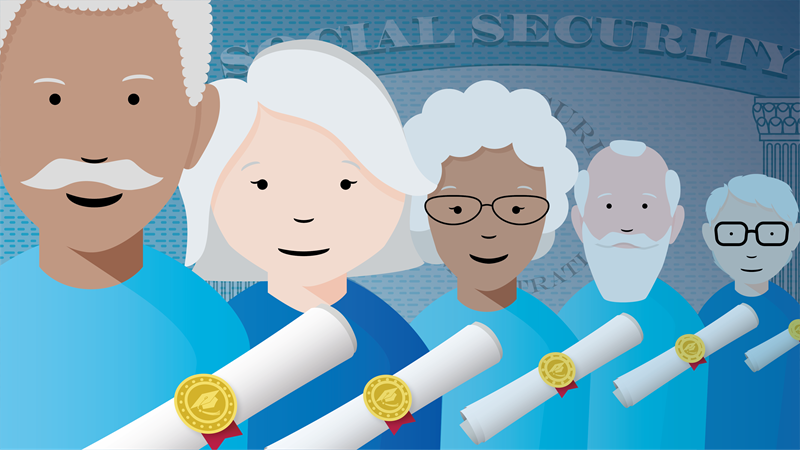
As physical and mental capacity diminishes with passing years, older adults will become increasingly dependent on others. This is often an emotional issue for adult children who care for aging parents. For many, it poses an economic burden as well.
This situation expands dramatically—if less personally—at the national level. The ratio of those 65 years and older to those 20-to-64 years will double in the United States from 25 percent in 2015 to 50 percent in 2080, according to United Nations estimates. For the world as a whole, the estimated ratio will more than double, rising from 14 percent to 37 percent.
Demographers and economists who study these higher “old-age dependency ratios” usually focus on just two factors: longer life spans and lower fertility. Inevitably, those trends mean more seniors and fewer working-age adults to support them in retirement. The economic implications are staggering. One recent study argues that financing the higher costs of Medicare, Medicaid, and Social Security would require as much as a 13-percentage-point increase in the labor tax rate.
The power of education
New research by Federal Reserve Bank of Minneapolis economist Timothy Kehoe and co-authors includes a third element—increasing college attainment—and suggests a less onerous labor tax hit. Higher college attainment contributes to the dependency ratio too, because it increases longevity (educated people live longer). But it has other effects that ultimately result in a lower boost in labor taxation. Specifically, it leads to higher productivity, lower government spending on Medicaid and other social safety net programs, higher tax revenues, and lower interest payments on government debt.
The net result: Adding increasing college attainment lowers the required increase in the labor tax rate by 10.2 percentage points.
The economists analyze the influence of increasing educational attainment in considerable detail and under several scenarios to fully understand the individual and collective impact of the three channels of aging. Their research illustrates the remarkable difficulty of forecasting the long-term economic implications of demographic change. Multiple moving parts—educational measures, tax rates, spending levels, fertility calculations, and other variables—must be accounted for; all are prone to mismeasurement and change.
More substantively, the work indicates that one crucial factor—education—has major implications for gauging impact and shaping policy. And it suggests that the economic weight of caring for the elderly will be less burdensome than previously thought.
A four-step process
Kehoe and colleagues start with a benchmark model in which some are college-educated and others not. Key social insurance programs (Medicare and the like) and other government expenditures are financed through taxes on consumption, capital income, and labor. The economists calibrate the model to match the U.S. economy in 2005. They then use it to study the macroeconomic implications of increasing college attainment, decreasing fertility, and increasing longevity through the year 2100.
The scholars explore their model economy in a step-by-step process, first looking at how each channel of population aging (education, fertility, longevity) individually affects various fiscal variables, particularly the labor tax rate needed to fund government spending. Then they examine joint fiscal implications—after all, in the real world, all three channels operate and interrelate simultaneously. The next step is pinpointing general equilibrium effects. In addition, they study economic welfare: How will increasing college attainment impact consumption levels?
Individual implications
Changing one factor at a time enables the economists to measure their distinct effects on labor income taxes. It also highlights how different increasing college attainment is from the other channels. Again, all three increase the dependency ratio (Figure 1), with increasing longevity having by far the strongest influence. But unlike the other two channels, the economists note, “Increasing college attainment allows the government to reduce labor taxes.” (Figure 2)
Why? Several reasons. Education leads to more productive workers, meaning higher earnings and higher revenue from taxing those earnings. College grads are less likely to need Medicaid and emergency relief like disability insurance, thereby lowering government spending. College grads consume and save more than non-college grads; that boosts revenue from consumption and capital taxes. Increasing education also lowers interest payments on government debt because it boosts capital stocks. That means lower interest rates.
Increasing college attainment moves variables in the other direction too. It increases spending on Medicare and Social Security because the college-educated live longer and claim higher benefits. And lower interest rates dampen the increase in capital income tax revenues. But on net, the effect of education is sharply positive.
All together now
So what happens when all three channels operate and interact? For virtually every variable examined, the collective impact is larger than the sum of individual effects—that is, interaction amplifies their discrete impacts. And, notably, the economists find that introducing increasing college attainment to a model with decreasing fertility and increasing longevity massively lowers the required increase in the labor tax rate.
That result is tempered, however, in a more comprehensive model that allows the economists to understand a negative consequence of higher educational attainment: lower capital income tax revenues. The sequence is intricate: Higher college attainment leads to greater capital accumulation because college grads save more of what they earn. They earn more because wages are higher and they work longer hours. Larger capital stocks lower interest rates. On the one hand, lower rates decrease government spending on interest payments; on the other, they also lower the increase in capital income tax revenues.
In sum: A lower hike in labor tax and higher consumption
Even with lower capital tax revenues, the results are positive and substantial. Increasing college attainment lowers the required increase in the labor tax rate by 10.2 percentage points from what would be necessary if only decreasing fertility and increasing longevity were accounted for.
The implications are significant for everyone, whether or not they graduate college, according to the economists’ estimates. In a higher college attainment environment, economic welfare—measured as percentage change in consumption—would be at least 17.4 percentage points higher for a 20-year-old in the year 2100.





